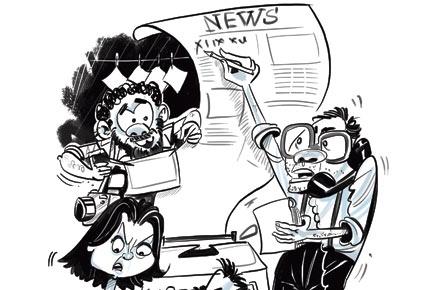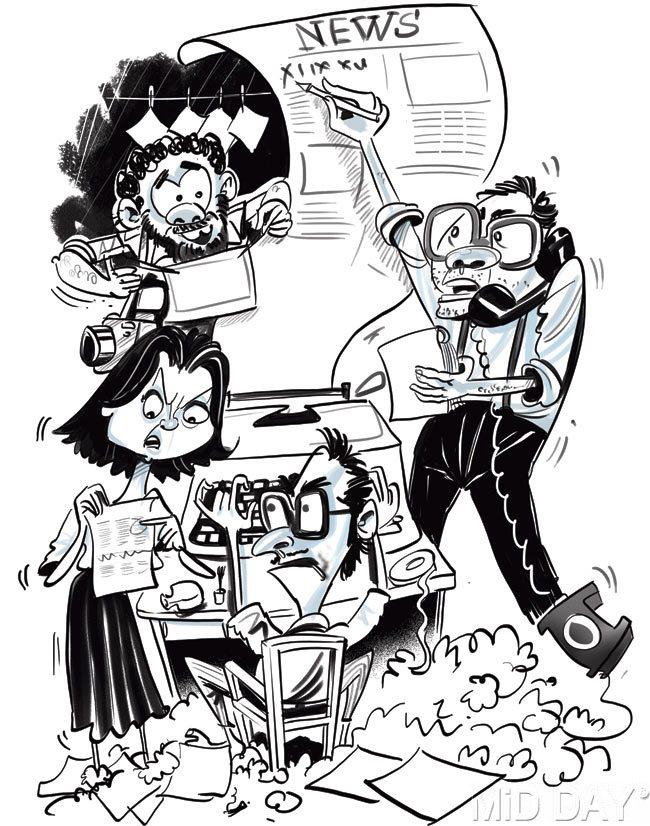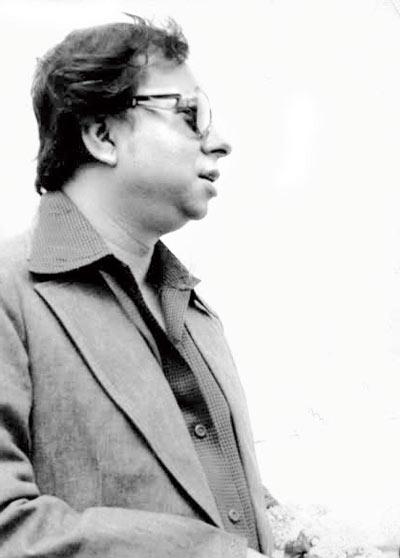The city — sliced, diced and served with a dash of sauce

Black and white and nifty shades of grey
Marcellus Baptista takes a cheeky look back at the ups and downs of newspaper production over the years
ADVERTISEMENT
And how was it bringing out a newspaper 35 years ago? Well, you had to know how to type without looking at the keys, or you could peer at the keys and type with just two fingers if you had not learnt to type after your basic formal education.

Illustrations/Amit Bandre
You had to be adept in banging your fingers on the typewriter keys so that the letters would jump out from the machine and hit the white paper rolled out before you, forming words and sentences and paragraphs.
There was no delete button, you had to xxx out the word if it was the wrong word or you thought that another word would be more appropriate. You also had to know how to change the ribbon in the typewriter and ignore your fingers being smeared black and red in the process.
The report or article would then be sent to the sub-editor who would use a ballpoint pen to mark paragraphs, correct spelling (no spell-check on the manual typewriter!) and write a suitable headline. The copy would then go to the chief sub-editor who would very often reject the headline and give another one and then off it would go to the composing department.
The text would get composed in lead, and the composed matter would be carefully carried to the page-maker who would place it according to the layout prepared by the chief sub-editor on a piece of paper. Photographs were hard-copy black and white ones that were developed in the darkroom and then made into blocks, which is how they were printed.
There were also proof-readers who compared the composed matter against the original typed copy, and marked changes in red ink for the compositor to change. The news would come from reporters rushing to their typewriters with stories in their heads and jottings in their notebooks.
The news would also arrive via the chatter and whirr of the teleprinters spewing off bursts of news on paper — it was breaking news at its best as the journalists huddled around the machines, especially with big events unfolding around the world.
Before the paper went to press the proof of each page would be okayed by the chief sub-editor or the news editor who also checked whether the day and date of the edition was correct. The printing press was usually in the basement of the same building, and it was a thrill to see the reams of paper and the roll of the machine as the first copy spewed out in all its black and white glory with, perhaps, nifty shades of grey.
The printer’s ink would smear your fingers and you washed that out in the washroom down the corridor, packed your bags or folded your old-fashioned notebook, put the ballpoint pen back in your shirt pocket and headed to the Press Club for a much-needed Old Monk.
How RD got his kicks
Chaitanya Padukone recalls musical great Pancham’s penchant for football, on his birth anniversary
Had legendary Bollywood composer-singer Rahul Dev Burman (aka Panchamda) been alive today, he would be religiously watching his favourite teams playing in the ongoing FIFA World Cup football matches.

R D Burman
The innovative genius, whose 75th birth anniversary it is today, was an ardent football freak. While his favourite desi team was East Bengal, he would make it a point to sneak out to the city Cooperage grounds with his buddies to watch tournaments.
After returning from watching the deft dribbling and agile goal-scoring sessions, RDB would rush to the Film Center recording studio at Tardeo and scribble out fresh improvised music notations. “Watching football actually gives me an inspirational ‘kick’. In music you write the ‘score’ and in soccer its the goal-score,” was his favourite repartee.
The rhythm-savvy RDB had a fetish for anything that had a Brazilian tag their pulsating music, their vibrant dances, and of course their famous football team, Pele being his all-time favourite. Among RDB’s favorite Brazilian rhythms was the bossa nova, and he blended those foot-tapping beats in nearly a dozen of his chartbusting numbers.
Call it a brain-drain of sorts, but Panchamda’s Latin American album Pantera (1987), released in South America, had caught the fancy of the Brazilian youth. Among RD’s prime regrets was that cricket-obsessed India never qualified for the FIFA World Cup.
An uncanny coincidence for die-hard Pancham fans who are also hooked on to soccer, is that the year (1994) in which he passed away, Brazil won the FIFA World Cup. And this year when it is RDB’s platinum birth anniversary, the venue is Brazil! Viva Panchamda and your ‘scores’!
The writer, a senior film journalist, has interviewed RD Burman exclusively for mid-day on various occasions, and shared a warm rapport with the otherwise media-shy composer
 Subscribe today by clicking the link and stay updated with the latest news!" Click here!
Subscribe today by clicking the link and stay updated with the latest news!" Click here!






